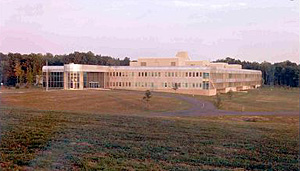Readers seek help for preservation emergencies
/ June 21, 2005
 |
|
COMSAT Laboratories occupies
150 acres in Clarksburg, Md.
|
Dear Preservation 911,
The COMSAT Laboratories Building
at 22300 Comsat Drive, visible from the I-270 "high-technology"
corridor in Clarksburg, Md., and 34 miles northwest of downtown
Washington, D.C., is threatened with demolition. The roughly 150-acre
site has been sold to a developer who plans to file for a mixed-use
rezoning permit to construct townhouses, offices, retail, and
light industry on the pastoral site.
Cesar Pelli, while director of
design for Daniel, Mann, Johnson & Mendenhall, designed the
1969 building for COMSAT's research and development laboratories,
which were working under a mandate from President Kennedy to create
a global communications satellite industry for commercial purposes.
More than 300 patents were filed based on the research and technology
pioneered at the building in the area of commercial satellite
communication.
Not only does the building have
extraordinary significance in the scientific and technological
arena, but it was one of the first in the Washington area to fully
capitalize on the "high-tech" esthetic. Pelli drew inspiration
from the sleek exteriors of airplanes as evidenced in the building's
prefabricated aluminum paneled walls and softly rounded flush
glass windows. These materials are coordinated into a seamless,
futuristic building that has become an icon in the Washington
metropolitan landscape. It is the most familiar building on the
Interstate-270 corridor, the gateway to the county's high-technology
"main street." The quintessential "machine in the
garden," COMSAT Laboratories is an early Pelli masterpiece
sitting currently on a pastoral setting. It is a building and
site that the architect himself has gone on record as saying deserves
protection.
Although the Montgomery County
Historic Preservation Commission approved the preservation of
the building and a 33-acre environmental setting in April 2005,
the building is still extremely threatened. On May 26, the case
was heard before the Montgomery County Planning Board. Testimony
was taken from the Historic Preservation Staff in support of designation.
The building owners, LCOR, Inc., a Berwyn, Pennsylvania-based
development company, claim that Pelli's credit for the building
remains in question, that designation will threaten all potential
business interests in the county, and that the scientific accomplishments
of the laboratories are just "window dressing" for Park
and Planning's desire to designate a Pelli building.
Regarding the attribution of
the building, Pelli himself has written three communications to
the Planning Board and/or Historic Preservation staff supporting
designation. The nomination for historic designation was prepared
in November 2004 by Professors Isabelle Gournay and Mary Corbin
Sies, both faculty at the University of Maryland (Schools of Architecture
and Historic Preservation Faculty). It is a thoroughly researched
work (both professors are considered the experts in modern architecture
in Maryland) that places equal emphasis on the historical/scientific
and architectural significance of the building.
The Planning Board did not vote
in May because the Chairman was absent. The Planning Board work
session and a vote will be taken up on July 7, 2005. The case
moves on to the Montgomery County Council in the fall.
For more information, contact:
Gwen Wright, Historic Preservation Supervisor
Montgomery County Department of Park and Planning Historic Preservation
Section
(301) 563-3413
Sincerely,
Ms. Joey Lampl
Architectural Historian/Preservation Planner
Preservation 911 is a message
board open to all readers. While National Trust staff will respond
to the extent feasible, this will not be possible in all cases.
We encourage other readers involved in state or local preservation
to respond with advice or assistance. To contact either a regional
office of the National Trust, a statewide or local nonprofit
organization, or your state's historic preservation office,
The National Trust's regional
and field offices bring the programs and tools of the Trust
to communities across the country. They offer technical assistance
through consultations and field visits and financial help through
small grants. They hold educational programs for professional
preservationists and work to foster policies that help historic
places. They also provide leadership on issues that concern
entire regions, such as saving historic schools, fighting sprawl,
and revitalizing cities.
|